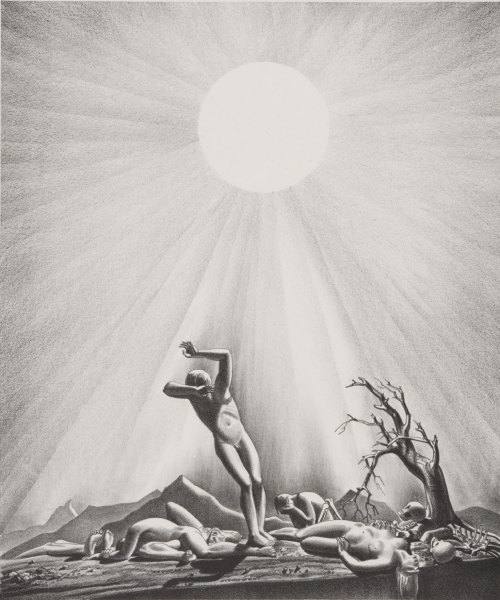 |
| Ellison Hoover, George C. Miller, Lithographer, 1949, lithograph. Image courtesy of http://americanart.si.edu/collections/search/artwork/?id=10749 |
Miller soon realized that there was a high demand among artists for master printers. While there were plenty of lithography shops around at the time, most of them didn't see the commercial value of printing for artists, due to the small size of the editions and the amount of time and effort required to create them. Miller, however, recognized an opportunity, and soon began printing exclusively for artists, becoming one of only a handful of printers in the country at that time to do so. It wasn't always financially easy, sometimes he had to take on other jobs such as teaching to make ends meet, but even in the most difficult of times Miller found a way to make it work.
Unlike Bolton Brown, another master lithographer who was an artist as well as printer, Miller thought of himself primarily as a craftsperson. His job was to take an artist's idea and make it a lithographic reality, regardless of how he personally felt about the aesthetics of the work. As a result, Miller worked with a variety of artists, though the crisp, clear style of Precisionism seemed to especially appeal to his working method.
Since there were so few master printers willing to print for artists at the time, Miller worked with some big names in the art world, including Rockwell Kent, with whom he also became good friends.
 |
| Rockwell Kent, Solar Flare-Up, from the series End of the World, 1937, lithograph. Image courtesy of http://www.philamuseum.org/collections/permanent/67167.html?mulR=15074%7C7 |
Another artist who collaborated with Miller on a regular basis was Louis Lozowick, who was greatly influenced by Russian Constructivism during the early part of his own career. This print was actually featured in an RMAC show last year, Giving a Good Impression.
 |
| Louis Lozowick, Hanover Square, 1929, lithograph. Image courtesy of http://americanart.si.edu/collections/search/artwork/?id=15057
Howard Cook also worked with Miller, especially when he was working on more streamlined, urban subjects such as his New York scenes. Cook held the printer in very high esteem.
|
 |
| Howard Cook, George Washington Bridge with B, 1931, lithograph. Image courtesy of http://www.oldprintshop.com/cgi-bin/gallery.pl?action=detail&inventory_id=24862&itemno=2
Mabel Dwight achieved acclaim for her sympathetic, often humorous portrayals of human society.
|
 |
| Mabel Dwight, In the Crowd, 1931, lithograph on paper. Image courtesy of http://www.loc.gov/exhibits/goldstein/goldart.html |
Want to learn more? What I'd recommend is finding the book American Lithographers, 1900-1960: The Artists and Their Printers, by Clinton Adams, printmaker, historian, and co-founder of Tamarind Institute. This volume provides a great overview of American lithography during the first half of the twentieth century. It discusses Miller, Brown, and the other major printers working for artists during this time period.
http://books.google.com/books/about/American_lithographers_1900_1960.html?id=hjlQAAAAMAAJ
Comments
Post a Comment
Questions? Comments? Speak your mind here.